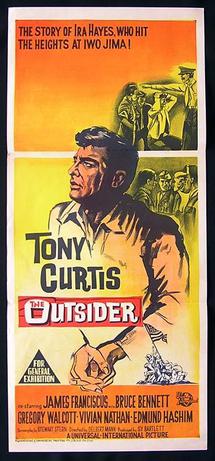| The Outsider | |
|---|---|
 Australian film poster | |
| Directed by | Delbert Mann |
| Screenplay by | Stewart Stern |
| Based on | The Hero of Iwo Jima by William Bradford Huie |
| Produced by | Sy Bartlett |
| Starring | Tony Curtis |
| Cinematography | Joseph LaShelle, A.S.C. |
| Edited by | Marjorie Fowler, A.C.E. |
| Music by | Leonard Rosenman (composed and conducted) |
| Distributed by | Universal-International |
Release date |
|
Running time | 108 minutes |
| Country | United States |
| Language | English |
The Outsider is a 1961 biopic film about Ira Hayes, a Native American who fought in World War II in the United States Marine Corps and was one of the Marines who raised the flag on Iwo Jima. The film stars Tony Curtis as Hayes. It was directed by Delbert Mann.
Contents
Jim Sorenson, a Marine depicted as Hayes's best friend is a fictional composite of Franklin Sousley and Harlon Block, who raised the flag. The movie was adapted from an article by William Bradford Huie about Hayes.
